1.准备tab的图标,放到mipmap目录下面,大小64x64,准备2种,一种是选中的,一种是未选中的,如下图
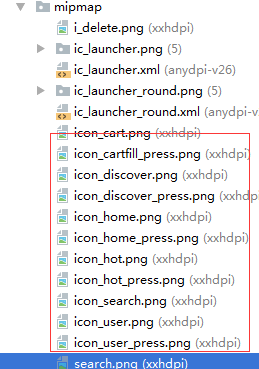
2.重写fragmentabhost,防止调用fragment每次点击tab都要重新调用oncreateview方法.,这里的目录是
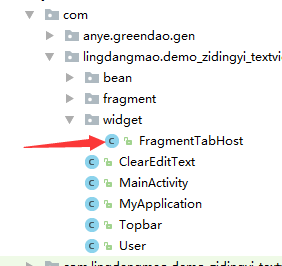
代码部分
package com.lingdangmao.demo_zidingyi_textview.widget; /** * Created by monkey * on 2014/9/24 * 功能描述:修改过的FragmentTabHost,保存fragment实例不销毁 */ /* * Copyright (C) 2012 The Android Open Source Project * * Licensed under the Apache License, Version 2.0 (the "License"); * you may not use this file except in compliance with the License. * You may obtain a copy of the License at * * http://www.apache.org/licenses/LICENSE-2.0 * * Unless required by applicable law or agreed to in writing, software * distributed under the License is distributed on an "AS IS" BASIS, * WITHOUT WARRANTIES OR CONDITIONS OF ANY KIND, either express or implied. * See the License for the specific language governing permissions and * limitations under the License. */ import java.util.ArrayList; import android.content.Context; import android.content.res.TypedArray; import android.os.Bundle; import android.os.Parcel; import android.os.Parcelable; import android.support.v4.app.Fragment; import android.support.v4.app.FragmentManager; import android.support.v4.app.FragmentTransaction; import android.util.AttributeSet; import android.view.View; import android.view.ViewGroup; import android.widget.FrameLayout; import android.widget.LinearLayout; import android.widget.TabHost; import android.widget.TabWidget; /** * Special TabHost that allows the use of {@link Fragment} objects for its tab * content. When placing this in a view hierarchy, after inflating the hierarchy * you must call {@link #setup(Context, FragmentManager, int)} to complete the * initialization of the tab host. * * <p> * Here is a simple example of using a FragmentTabHost in an Activity: * * {@sample * development/samples/Support4Demos/src/com/example/android/supportv4/app/ * FragmentTabs.java complete} * * <p> * This can also be used inside of a fragment through fragment nesting: * * {@sample * development/samples/Support4Demos/src/com/example/android/supportv4/app/ * FragmentTabsFragmentSupport.java complete} */ public class FragmentTabHost extends TabHost implements TabHost.OnTabChangeListener { private final ArrayList<TabInfo> mTabs = new ArrayList<TabInfo>(); private FrameLayout mRealTabContent; private Context mContext; private FragmentManager mFragmentManager; private int mContainerId; private TabHost.OnTabChangeListener mOnTabChangeListener; private TabInfo mLastTab; private boolean mAttached; static final class TabInfo { private final String tag; private final Class<?> clss; private final Bundle args; private Fragment fragment; TabInfo(String _tag, Class<?> _class, Bundle _args) { tag = _tag; clss = _class; args = _args; } } static class DummyTabFactory implements TabHost.TabContentFactory { private final Context mContext; public DummyTabFactory(Context context) { mContext = context; } @Override public View createTabContent(String tag) { View v = new View(mContext); v.setMinimumWidth(0); v.setMinimumHeight(0); return v; } } static class SavedState extends BaseSavedState { String curTab; SavedState(Parcelable superState) { super(superState); } private SavedState(Parcel in) { super(in); curTab = in.readString(); } @Override public void writeToParcel(Parcel out, int flags) { super.writeToParcel(out, flags); out.writeString(curTab); } @Override public String toString() { return "FragmentTabHost.SavedState{" + Integer.toHexString(System.identityHashCode(this)) + " curTab=" + curTab + "}"; } public static final Parcelable.Creator<SavedState> CREATOR = new Parcelable.Creator<SavedState>() { public SavedState createFromParcel(Parcel in) { return new SavedState(in); } public SavedState[] newArray(int size) { return new SavedState[size]; } }; } public FragmentTabHost(Context context) { // Note that we call through to the version that takes an AttributeSet, // because the simple Context construct can result in a broken object! super(context, null); initFragmentTabHost(context, null); } public FragmentTabHost(Context context, AttributeSet attrs) { super(context, attrs); initFragmentTabHost(context, attrs); } private void initFragmentTabHost(Context context, AttributeSet attrs) { TypedArray a = context.obtainStyledAttributes(attrs, new int[] { android.R.attr.inflatedId }, 0, 0); mContainerId = a.getResourceId(0, 0); a.recycle(); super.setOnTabChangedListener(this); } private void ensureHierarchy(Context context) { // If owner hasn't made its own view hierarchy, then as a convenience // we will construct a standard one here. if (findViewById(android.R.id.tabs) == null) { LinearLayout ll = new LinearLayout(context); ll.setOrientation(LinearLayout.VERTICAL); addView(ll, new FrameLayout.LayoutParams( ViewGroup.LayoutParams.MATCH_PARENT, ViewGroup.LayoutParams.MATCH_PARENT)); TabWidget tw = new TabWidget(context); tw.setId(android.R.id.tabs); tw.setOrientation(TabWidget.HORIZONTAL); ll.addView(tw, new LinearLayout.LayoutParams( ViewGroup.LayoutParams.MATCH_PARENT, ViewGroup.LayoutParams.WRAP_CONTENT, 0)); FrameLayout fl = new FrameLayout(context); fl.setId(android.R.id.tabcontent); ll.addView(fl, new LinearLayout.LayoutParams(0, 0, 0)); mRealTabContent = fl = new FrameLayout(context); mRealTabContent.setId(mContainerId); ll.addView(fl, new LinearLayout.LayoutParams( LinearLayout.LayoutParams.MATCH_PARENT, 0, 1)); } } /** * @deprecated Don't call the original TabHost setup, you must instead call * {@link #setup(Context, FragmentManager)} or * {@link #setup(Context, FragmentManager, int)}. */ @Override @Deprecated public void setup() { throw new IllegalStateException( "Must call setup() that takes a Context and FragmentManager"); } public void setup(Context context, FragmentManager manager) { ensureHierarchy(context); // Ensure views required by super.setup() super.setup(); mContext = context; mFragmentManager = manager; ensureContent(); } public void setup(Context context, FragmentManager manager, int containerId) { ensureHierarchy(context); // Ensure views required by super.setup() super.setup(); mContext = context; mFragmentManager = manager; mContainerId = containerId; ensureContent(); mRealTabContent.setId(containerId); // We must have an ID to be able to save/restore our state. If // the owner hasn't set one at this point, we will set it ourself. if (getId() == View.NO_ID) { setId(android.R.id.tabhost); } } private void ensureContent() { if (mRealTabContent == null) { mRealTabContent = (FrameLayout) findViewById(mContainerId); if (mRealTabContent == null) { throw new IllegalStateException( "No tab content FrameLayout found for id " + mContainerId); } } } @Override public void setOnTabChangedListener(OnTabChangeListener l) { mOnTabChangeListener = l; } public void addTab(TabHost.TabSpec tabSpec, Class<?> clss, Bundle args) { tabSpec.setContent(new DummyTabFactory(mContext)); String tag = tabSpec.getTag(); TabInfo info = new TabInfo(tag, clss, args); if (mAttached) { // If we are already attached to the window, then check to make // sure this tab's fragment is inactive if it exists. This shouldn't // normally happen. info.fragment = mFragmentManager.findFragmentByTag(tag); if (info.fragment != null && !info.fragment.isDetached()) { FragmentTransaction ft = mFragmentManager.beginTransaction(); // ft.detach(info.fragment); ft.hide(info.fragment); ft.commit(); } } mTabs.add(info); addTab(tabSpec); } @Override protected void onAttachedToWindow() { super.onAttachedToWindow(); String currentTab = getCurrentTabTag(); // Go through all tabs and make sure their fragments match // the correct state. FragmentTransaction ft = null; for (int i = 0; i < mTabs.size(); i++) { TabInfo tab = mTabs.get(i); tab.fragment = mFragmentManager.findFragmentByTag(tab.tag); // if (tab.fragment != null && !tab.fragment.isDetached()) { if (tab.fragment != null) { if (tab.tag.equals(currentTab)) { // The fragment for this tab is already there and // active, and it is what we really want to have // as the current tab. Nothing to do. mLastTab = tab; } else { // This fragment was restored in the active state, // but is not the current tab. Deactivate it. if (ft == null) { ft = mFragmentManager.beginTransaction(); } // ft.detach(tab.fragment); ft.hide(tab.fragment); } } } // We are now ready to go. Make sure we are switched to the // correct tab. mAttached = true; ft = doTabChanged(currentTab, ft); if (ft != null) { ft.commit(); mFragmentManager.executePendingTransactions(); } } @Override protected void onDetachedFromWindow() { super.onDetachedFromWindow(); mAttached = false; } @Override protected Parcelable onSaveInstanceState() { Parcelable superState = super.onSaveInstanceState(); SavedState ss = new SavedState(superState); ss.curTab = getCurrentTabTag(); return ss; } @Override protected void onRestoreInstanceState(Parcelable state) { SavedState ss = (SavedState) state; super.onRestoreInstanceState(ss.getSuperState()); setCurrentTabByTag(ss.curTab); } @Override public void onTabChanged(String tabId) { if (mAttached) { FragmentTransaction ft = doTabChanged(tabId, null); if (ft != null) { ft.commit(); } } if (mOnTabChangeListener != null) { mOnTabChangeListener.onTabChanged(tabId); } } private FragmentTransaction doTabChanged(String tabId, FragmentTransaction ft) { TabInfo newTab = null; for (int i = 0; i < mTabs.size(); i++) { TabInfo tab = mTabs.get(i); if (tab.tag.equals(tabId)) { newTab = tab; } } if (newTab == null) { throw new IllegalStateException("No tab known for tag " + tabId); } if (mLastTab != newTab) { if (ft == null) { ft = mFragmentManager.beginTransaction(); } if (mLastTab != null) { if (mLastTab.fragment != null) { // ½«detachÌ滻Ϊhide£¬Òþ²ØFragment // ft.detach(mLastTab.fragment); ft.hide(mLastTab.fragment); } } if (newTab != null) { if (newTab.fragment == null) { newTab.fragment = Fragment.instantiate(mContext, newTab.clss.getName(), newTab.args); ft.add(mContainerId, newTab.fragment, newTab.tag); } else { // ½«attachÌ滻Ϊshow£¬ÏÔʾFragment // ft.attach(newTab.fragment); ft.show(newTab.fragment); } } mLastTab = newTab; } return ft; } }
3.编写activity_main布局文件
<?xml version="1.0" encoding="utf-8"?> <LinearLayout xmlns:android="http://schemas.android.com/apk/res/android" xmlns:app="http://schemas.android.com/apk/res-auto" xmlns:tools="http://schemas.android.com/tools" android:layout_width="match_parent" android:layout_height="match_parent" android:orientation="vertical" android:id="@+id/main_root_ll" tools:context="com.lingdangmao.demo_zidingyi_textview.MainActivity"> <FrameLayout android:id="@+id/realtabcontent" android:layout_weight="1" android:layout_width="match_parent" android:background="@color/bg_color" android:layout_height="0dp"> </FrameLayout> <com.lingdangmao.demo_zidingyi_textview.widget.FragmentTabHost android:id="@+id/tabhost" android:layout_width="match_parent" android:layout_height="wrap_content"> <FrameLayout android:layout_weight="0" android:id="@+id/tabcontent" android:layout_width="0dp" android:layout_height="0dp"> </FrameLayout> </com.lingdangmao.demo_zidingyi_textview.widget.FragmentTabHost> </LinearLayout>
4.编写mainactivity
public class MainActivity extends AppCompatActivity { private static final String TAG = "MainActivity"; private FragmentTabHost mTabHost; private LayoutInflater mLayoutInflater; private List<Tab> mTabs=new ArrayList<>(5); @Override protected void onCreate(Bundle savedInstanceState) { super.onCreate(savedInstanceState); setContentView(R.layout.activity_main); initTab(); } private void initTab() { mLayoutInflater =LayoutInflater.from(this); mTabHost = findViewById(R.id.tabhost); mTabHost.setup(this,getSupportFragmentManager(),R.id.realtabcontent); Tab tab_home =new Tab(R.string.home,R.drawable.selector_icon_home,HomeFragment.class); Tab tab_hot =new Tab(R.string.hot,R.drawable.selector_icon_hot,HotFragment.class); Tab tab_category =new Tab(R.string.catagory,R.drawable.selector_icon_category,CategoryFragment.class); Tab tab_cart =new Tab(R.string.cart,R.drawable.selector_icon_cart,CartFragment.class); Tab tab_mine =new Tab(R.string.mine,R.drawable.selector_icon_mine,MineFragment.class); mTabs.add(tab_home); mTabs.add(tab_hot); mTabs.add(tab_category); mTabs.add(tab_cart); mTabs.add(tab_mine); for (Tab tab: mTabs) { TabHost.TabSpec tabSpec = mTabHost.newTabSpec(getString(tab.getTitle())); tabSpec.setIndicator(buildIndicator(tab)); mTabHost.addTab(tabSpec, tab.getFragment(),null); } //去掉分割线 mTabHost.getTabWidget().setShowDividers(LinearLayout.SHOW_DIVIDER_NONE); //默认选择第一个 mTabHost.setCurrentTab(0); } private View buildIndicator(Tab tab){ View view= mLayoutInflater.inflate(R.layout.tab_indicator,null); ImageView imageView =view.findViewById(R.id.icon_tab); TextView textView =view.findViewById(R.id.txt_indicator); imageView.setBackgroundResource(tab.getIcon()); textView.setText(tab.getTitle()); return view; } }
写tab的样式

<?xml version="1.0" encoding="utf-8"?> <LinearLayout xmlns:android="http://schemas.android.com/apk/res/android" android:orientation="vertical" android:paddingTop="3dp" android:paddingBottom="3dp" android:gravity="center" android:layout_width="match_parent" android:layout_height="match_parent"> <android.support.v7.widget.AppCompatImageView android:id="@+id/icon_tab" android:layout_width="wrap_content" android:layout_height="wrap_content" /> <android.support.v7.widget.AppCompatTextView android:layout_marginTop="2dp" android:id="@+id/txt_indicator" android:textColor="@color/selector_tab_text" android:layout_width="wrap_content" android:layout_height="wrap_content" /> </LinearLayout>
写文字切换的样式

<?xml version="1.0" encoding="utf-8"?> <selector xmlns:android="http://schemas.android.com/apk/res/android"> <item android:state_selected="true" android:color="#eb4f38" /> <item android:state_active="true" android:color="#eb4f38"/> <item android:state_selected="false" android:color="#a9b7b7" /> <item android:state_active="false" android:color="#a9b7b7"/> </selector>
写图片切换的样式 ,这里只写了一个,其余参考写就行了
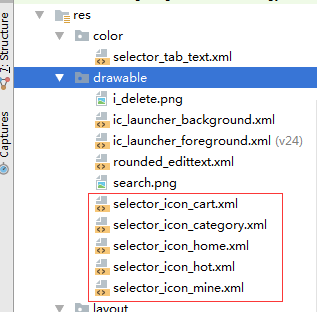
<?xml version="1.0" encoding="utf-8"?> <selector xmlns:android="http://schemas.android.com/apk/res/android"> <!-- Non focused states --> <item android:state_focused="false" android:state_selected="false" android:state_pressed="false" android:drawable="@mipmap/icon_cart" /> <item android:state_focused="false" android:state_selected="true" android:state_pressed="false" android:drawable="@mipmap/icon_cartfill_press" /> <!-- Focused states --> <item android:state_focused="true" android:state_selected="false" android:state_pressed="false" android:drawable="@mipmap/icon_cartfill_press" /> <item android:state_focused="true" android:state_selected="true" android:state_pressed="false" android:drawable="@mipmap/icon_cartfill_press" /> <!-- Pressed --> <item android:state_selected="true" android:state_pressed="true" android:drawable="@mipmap/icon_cartfill_press" /> <item android:state_pressed="true" android:drawable="@mipmap/icon_cartfill_press" /> </selector>
写fragment的布局,随便写了一个
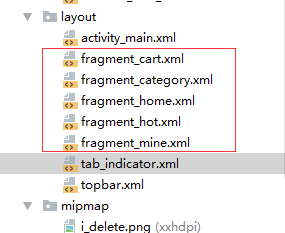
<?xml version="1.0" encoding="utf-8"?> <LinearLayout xmlns:android="http://schemas.android.com/apk/res/android" xmlns:app="http://schemas.android.com/apk/res-auto" android:orientation="vertical" android:layout_width="match_parent" android:layout_height="match_parent"> </LinearLayout>
values下面的
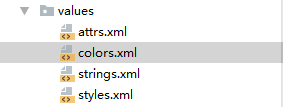
color
<?xml version="1.0" encoding="utf-8"?> <resources> <color name="colorPrimary">#3F51B5</color> <color name="colorPrimaryDark">#303F9F</color> <color name="colorAccent">#FF4081</color> <color name="bg_color">#f1f1f1</color> <color name="tab_text_unselected">#ccc</color> </resources>
string
<resources>
<string name="app_name">demo_zidingyi_textview</string>
<string name="home">主页</string>
<string name="hot">热卖</string>
<string name="catagory">分类</string>
<string name="cart">购物车</string>
<string name="mine">我的</string>
<string name="title_activity_ware_detail">WareDetailActivity</string>
<string name="share">分享</string>
</resources>
布局的fragment
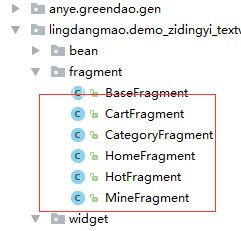
public class HotFragment extends Fragment { @Nullable @Override public View onCreateView(LayoutInflater inflater, @Nullable ViewGroup container, @Nullable Bundle savedInstanceState) { View view =inflater.inflate(R.layout.fragment_hot,container,false); return view; } }
初始化的tab
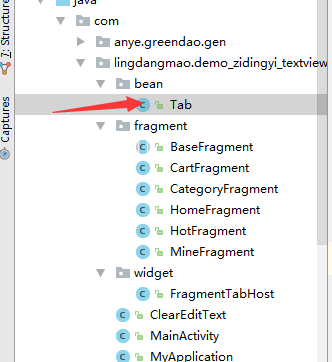
public class Tab { private int title; private int icon; private Class fragment; public Tab(int title,int icon,Class fragment){ this.title=title; this.icon=icon; this.fragment=fragment; } public void setFragment(Class fragment) { this.fragment = fragment; } public void setIcon(int icon) { this.icon = icon; } public void setTitle(int title) { this.title = title; } public Class getFragment() { return fragment; } public int getIcon() { return icon; } public int getTitle() { return title; } }